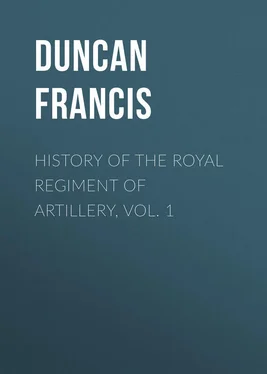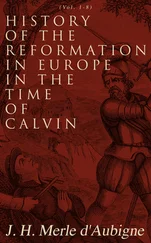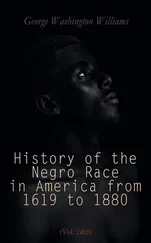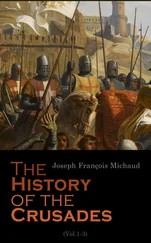Francis Duncan - History of the Royal Regiment of Artillery, Vol. 1
Здесь есть возможность читать онлайн «Francis Duncan - History of the Royal Regiment of Artillery, Vol. 1» — ознакомительный отрывок электронной книги совершенно бесплатно, а после прочтения отрывка купить полную версию. В некоторых случаях можно слушать аудио, скачать через торрент в формате fb2 и присутствует краткое содержание. Жанр: foreign_antique, foreign_prose, на английском языке. Описание произведения, (предисловие) а так же отзывы посетителей доступны на портале библиотеки ЛибКат.
- Название:History of the Royal Regiment of Artillery, Vol. 1
- Автор:
- Жанр:
- Год:неизвестен
- ISBN:нет данных
- Рейтинг книги:4 / 5. Голосов: 1
-
Избранное:Добавить в избранное
- Отзывы:
-
Ваша оценка:
- 80
- 1
- 2
- 3
- 4
- 5
History of the Royal Regiment of Artillery, Vol. 1: краткое содержание, описание и аннотация
Предлагаем к чтению аннотацию, описание, краткое содержание или предисловие (зависит от того, что написал сам автор книги «History of the Royal Regiment of Artillery, Vol. 1»). Если вы не нашли необходимую информацию о книге — напишите в комментариях, мы постараемся отыскать её.
History of the Royal Regiment of Artillery, Vol. 1 — читать онлайн ознакомительный отрывок
Ниже представлен текст книги, разбитый по страницам. Система сохранения места последней прочитанной страницы, позволяет с удобством читать онлайн бесплатно книгу «History of the Royal Regiment of Artillery, Vol. 1», без необходимости каждый раз заново искать на чём Вы остановились. Поставьте закладку, и сможете в любой момент перейти на страницу, на которой закончили чтение.
Интервал:
Закладка:
The use, therefore, of Artillery by the English has existed for centuries; but, – regarding it with modern eyes, its application would better deserve the term abuse . Nothing strikes the student so much as the absence of the scientific Artillery element in the early trains; and this feeling is followed by one of wonder at the patience with which our military leaders tolerated the almost total want of mobility which characterized them. Not until the last decade of the eighteenth century was the necessity of mobility officially recognized, by the establishment of the Royal Horse Artillery; and it took half a century more to impress upon our authorities that a Field Battery might not unreasonably be expected to move occasionally faster than a walk.
It is difficult, in reviewing such a period as the last fifteen years have been in the history of Artillery in England – so full of improvements in every way – to single out any one of these as more worthy of mention than the rest; but when posterity comes to review it dispassionately, the improvement in equipment and mobility of our Field Artillery will most probably be considered the prominent feature of the time. And these are the very qualities which for centuries remained in England unimproved and stagnant. The eighteenth century saw Artillery conducted by drivers, not under military discipline, nor marked by distinctive costume; who not unfrequently fled with their horses during the action, leaving the gunners helpless, and the guns at the mercy of the enemy. In this year, 1872, our drivers go into action unarmed, it being considered that the possession of defensive weapons might distract their attention from their horses. But we do not commit the old error of using men not under martial law. A driver who, on an emergency, finds himself with his whip merely to defend him, may possibly feel aggrieved: but however far he may run away, he cannot escape the embrace of the Mutiny Act, and is as liable to punishment as the man who deserts before the enemy, after his country has sent him into the field armed from head to foot.
In the very earliest days of Artillery in England, the number of gunners borne on permanent pay on the books of the Ordnance bore a very small proportion to the artificers so borne. With the increasing use of cannon, an increase in the number of artillerymen took place, but by no means pari passu : and, as towns in England became gradually fortified, a small number of gunners in each was found to be necessary to protect and take care of the stores, and to fire the guns on high days and holidays. In 1344, although no fewer than 321 artificers and engineers were borne on the books of the Ordnance in time of peace, only twelve gunners and seven armourers appear. In 1415, at the Siege of Harfleur, there were present 120 miners, 130 carpenters, and 120 masons; but only 25 master, and 50 servitor gunners – the latter corresponding probably to the matrosses of a later date. At the Siege of Tongue, in 1417, no less than 1000 masons, carpenters, and labourers were present, but only a small number of gunners. At this time, the driving of the guns, the placing them in position, and shipping and unshipping them, devolved on the civil labourers of the trains, and there was a military guard to escort the guns on the march. The gunner's duty seems to have been a general supervision of gun and stores, and the laying and firing it when in action. He was the captain of the gun in war – its custodian in peace. After the fifteenth century there was a marked increase in the number of artillerymen in the trains, although still totally inadequate. For example, in the train ordered on service in France, in 1544, where the civil element was represented by 157 artificers, 100 pioneers, and 20 carters, there were no less than 2 master-gunners, 264 gunners, and a special detachment of 15 gunners, for the guns placed immediately round the King's tent. The principal officers of the Ordnance also accompanied the expedition.
There was a distinction between the gunners of garrisons and those of the trains, as regarded the source of their pay, or rather its channel. At first, both were paid from the Exchequer; but after the proper establishment of an Ordnance Department at the Tower, the gunners of the various trains were paid by it, the others receiving their salaries as before. The company of fee'd gunners at the Tower of London differed from the gunners of other garrisons in receiving their pay from the Ordnance directly. It must not be imagined, however, that the gunners of garrisons were beyond the control of the Board of Ordnance because their pay was not drawn on the Ordnance books. Not merely had the Master of the Ordnance the nomination of the gunners of garrisons, but the power also of weeding out the useless and superannuated. The instance given in the Introductory Chapter of this volume, shows how directly they were under the Board in matters of discipline; and although, as a matter of Treasury detail, their pay was drawn in a different department, a word from the Ordnance Office could stop its issue to any gunner in any garrison who was deemed by the Board to have forfeited his right to it in any way. It was not until 1771, long after the formation of the Royal Artillery, that these garrison gunners were incorporated into the invalid companies of the regiment; and at the present date they are represented by what is called the Coast Brigade of Artillery. The pay of the old gunners of garrisons depended on the fort in which they resided. Berwick, for example, as an important station, was also one in which the gunner's pay was higher. In the reign of Edward VI. we find the average pay of a master-gunner was 1 s. a-day, and of the gunners, from 4 d. to 1 s. Later, the pay of the master-gunner was raised to 2 s. a-day, and that of the gunners rarely fell below 1 s. In time of war, the pay of the gunners of the trains far exceeded the above rates. The senior master-gunner was styled the Master-Gunner of England. From 2 s. a-day, which was the pay of this official in the sixteenth century, it rose to 160 l. per annum, and ultimately to 190 l. His residence and duties lay originally in the Tower, and chiefly among the fee'd gunners at that station; but after Woolwich had attained its speciality for Artillery details, quarters were allotted to him there in the Manor House. Among the oldest Master-Gunners of England whose names are recorded may be enumerated Christopher Gould, Richard Webb, Anthony Feurutter 3 3 Feurutter, according to Colonel Miller.
or Fourutter, 4 4 Fourutter, according to Colonel Cleaveland.
Stephen Bull, William Bull, William Hammond, John Reynold, and John Wornn – all of whom held their appointments in the sixteenth century, and the majority of them by letters patent from Elizabeth. From the fact that in the wording of their appointments two of the above are particularized as soldiers by profession, it would appear that the others were not so; and it is more probable that they were chosen for their knowledge of laboratory duties, and of the "making of pleasaunt and warlike fireworks."
The company of fee'd gunners at the Tower, which might be supposed to have had some military organization, really appears to have had little or none. Their number in Edward VI.'s reign was 58, with a master-gunner; but gradually it was increased to 100, which for many years was the normal establishment. They were supposed to parade twice a week, and learn the science of gunnery, under the Master-Gunner of England; but their attendance was so irregular, and their ignorance of their profession so deplorable, that a strong measure had to be adopted, to which allusion will be made in a later chapter. Colonel Miller, in his researches among the warrants appointing the gunners, found some venerable recruits – who can hardly have been of much value in the field – of ages varying from sixty-four to ninety-two. There is no doubt that these appointments were frequently sold, or given in return for personal or political services, without any regard to the capability of the recipient. The clerks at the Ordnance Office had their fees for preparing these men's warrants, whose wording of the duties expected of the nominee must have frequently read like a grotesque satire. The situations were desirable because they did not interfere with the holders continuing to work at their trades near the Tower; and if the gunners were ordered to Woolwich for the purpose of mounting guns, or shipping and unshipping stores, they received working pay in addition to their regular salaries. It was from their ranks that the vacancies among master-gunners and gunners of garrisons were almost invariably filled.
Читать дальшеИнтервал:
Закладка:
Похожие книги на «History of the Royal Regiment of Artillery, Vol. 1»
Представляем Вашему вниманию похожие книги на «History of the Royal Regiment of Artillery, Vol. 1» списком для выбора. Мы отобрали схожую по названию и смыслу литературу в надежде предоставить читателям больше вариантов отыскать новые, интересные, ещё непрочитанные произведения.
Обсуждение, отзывы о книге «History of the Royal Regiment of Artillery, Vol. 1» и просто собственные мнения читателей. Оставьте ваши комментарии, напишите, что Вы думаете о произведении, его смысле или главных героях. Укажите что конкретно понравилось, а что нет, и почему Вы так считаете.












